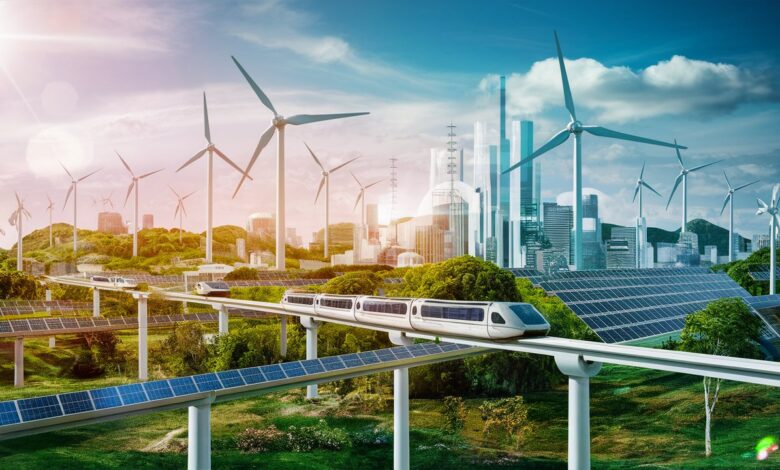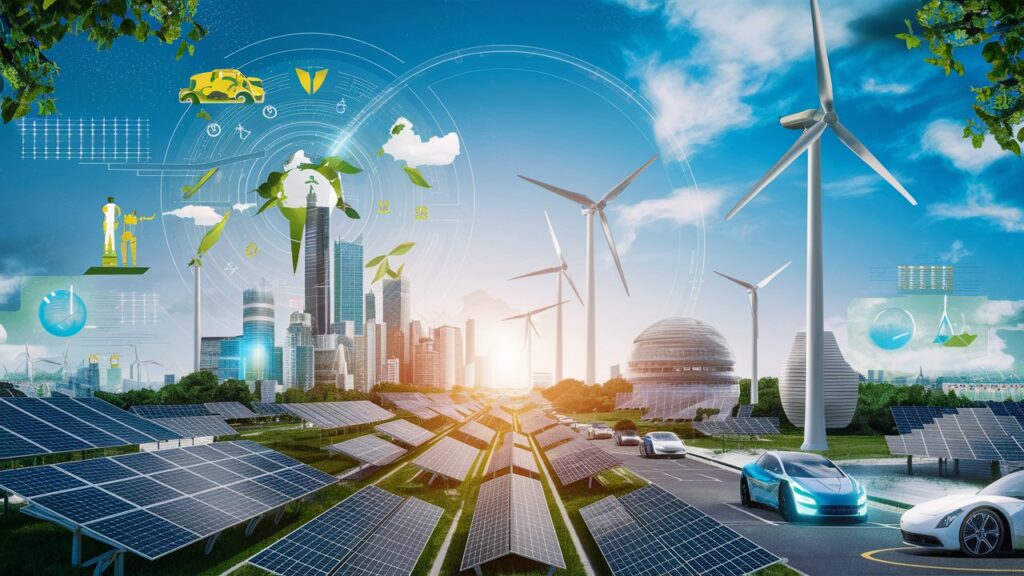Harnessing the Future: How Renewable Energy is Reshaping Our World

Introduction
The global energy landscape stands at a pivotal crossroads, defined by both unprecedented environmental challenges and transformative technological opportunities. As climate change accelerates and traditional fossil fuel reserves dwindle, the imperative to transition toward sustainable energy sources has evolved from an idealistic vision to an urgent necessity. Renewable energy—derived from inexhaustible natural forces like sunlight, wind, water, and geothermal heat—represents not merely an alternative, Harnessing the Future but the cornerstone of a resilient, equitable, and prosperous future. This shift transcends technological innovation; it embodies a fundamental reimagining of how societies generate power, steward resources, and distribute economic opportunity. The journey toward a decarbonized world is complex, requiring unprecedented collaboration between governments, industries, and communities. Yet, the convergence of falling costs, policy momentum, and public demand signals a tipping point. This article explores the multifaceted dimensions of the renewable revolution, examining its technological pillars, socioeconomic implications, persistent challenges, and the profound potential to redefine human progress in the 21st century.
The Imperative for Energy Transformation
The combustion of coal, oil, and gas has powered industrial advancement for centuries, but its legacy now threatens planetary stability. Greenhouse gas emissions from fossil fuels are the primary driver of global warming, intensifying extreme weather events, sea-level rise, and biodiversity collapse. Simultaneously, energy inequity persists: nearly 760 million people lack access to electricity, predominantly in developing regions. Renewable technologies offer a dual solution: drastically reducing carbon emissions while democratizing energy access through decentralized systems like solar microgrids. The geopolitical volatility linked to fossil fuel extraction further underscores the strategic value of energy independence via renewables. International frameworks like the Paris Agreement have galvanized national commitments, yet achieving net-zero targets demands scaling renewables at an exponential pace—a feat requiring systemic policy reforms, infrastructure investment, and cultural shifts in consumption patterns.
Solar Power: Capturing the Sun’s Boundless Potential
Solar energy harnesses photovoltaic (PV) cells or concentrated solar power (CSP) systems to convert sunlight directly into electricity. PV installations—ranging from rooftop panels to utility-scale solar farms—dominate the market due to plunging costs (down 90% since 2010) and modular scalability. Innovations like bifacial panels (capturing light from both sides) and perovskite tandem cells promise even greater efficiency breakthroughs. Beyond hardware, smart inverters and AI-driven management systems optimize grid integration, mitigating intermittency concerns. Solar’s socioeconomic impact is equally transformative, creating jobs in manufacturing and installation while empowering off-grid communities. In regions like sub-Saharan Africa, pay-as-you-go solar kits replace kerosene lamps, improving health outcomes and enabling education after dark. However, challenges remain, including land-use conflicts for large projects and recycling end-of-life panels—a hurdle the industry addresses through circular economy initiatives.
Wind Energy: Engineering the Sky’s Kinetic Force
Wind turbines, standing as modern sentinels across plains and coastlines, epitomize the scalability of renewable technology. Onshore wind farms leverage proven engineering, while offshore installations—bolstered by stronger, steadier winds—unlock vast untapped potential, particularly in coastal nations. Floating turbine technology now enables deployment in deep waters, expanding viable sites. The evolution of turbine design—taller towers, longer blades, and digital twin simulations—boosts energy capture and durability. Grid operators increasingly rely on wind’s predictability, enhanced by advanced forecasting algorithms that balance supply with demand. Economically, wind projects stimulate rural revitalization; farmers lease land for turbines while continuing agriculture, creating dual revenue streams. Yet, challenges like wildlife impacts (notably bird and bat collisions) necessitate ongoing research into deterrent systems and siting protocols. Transmission bottlenecks also require massive grid upgrades to channel wind-rich areas to population centers.
Hydropower: The Enduring Giant of Renewables
As the oldest and most established renewable source, hydropower generates over 16% of global electricity. Mega-dams like China’s Three Gorges showcase immense capacity, but smaller run-of-river and pumped-storage facilities gain traction for lower environmental disruption. Pumped hydro acts as a “natural battery,” storing excess solar or wind energy by pumping water uphill for later release during peak demand. Modern fish-friendly turbines Harnessing the Future and sediment management techniques mitigate ecological damage, while digital sensors optimize flow control and energy output. In developing economies, micro-hydro projects provide reliable power to remote villages without grid access. However, droughts intensified by climate change expose hydropower’s vulnerability to shifting weather patterns, emphasizing the need for diversified renewable portfolios.

Geothermal and Emerging Innovations: Tapping Earth’s Hidden Heat
Geothermal energy exploits subterranean heat for electricity or direct heating, offering baseload power unaffected by weather. Enhanced Geothermal Systems (EGS)—which inject water into hot rock formations—could unlock resources globally, transcending traditional volcanic regions. Beyond geothermal, emerging technologies like green hydrogen (produced via renewable-powered electrolysis) promise decarbonization for heavy industries and shipping. Ocean energy—including tidal barrages and wave converters—remains nascent but holds vast potential for island nations. Meanwhile, AI and blockchain enable peer-to-peer energy trading, allowing homeowners to sell surplus solar power to neighbors, fostering community resilience.
Policy, Economics, and the Road Ahead
Government policies—from feed-in tariffs to renewable portfolio standards—remain pivotal in accelerating adoption. Investment trends reveal surging confidence: global renewables spending now exceeds fossil fuels, with solar and wind attracting over $300 billion annually. Carbon pricing mechanisms further incentivize transitions by internalizing pollution costs. However, fossil fuel subsidies ($7 trillion in 2022, per the IMF) distort markets and require phaseouts. Equitable financing models must bridge the Global South’s investment gap, where high capital costs hinder deployment. Workforce retraining programs ensure fossil-dependent communities participate in the green economy. Ultimately, systemic change hinges on viewing renewables not just as energy sources, but as engines of holistic sustainability—reducing air pollution, conserving water, and fostering energy justice.
Conclusion
Harnessing the Future The renewable energy transition is no longer a speculative future—it is an unfolding reality reshaping geopolitics, economies, and ecosystems. While obstacles like grid modernization, material supply chains, and policy coherence persist, the collective will to overcome them grows stronger. Each solar panel installed, wind turbine erected, and geothermal well drilled represents a step toward a world where energy sustains rather than depletes, empowers rather than impoverishes, and heals rather than harms. This transformation demands bold leadership and civic engagement, but its rewards—a stable climate, resilient communities, and boundless innovation—are humanity’s most profound inheritance. As we harness Earth’s natural rhythms to power our societies, we forge not just clean energy, but a renewed covenant with the planet and future generations.
Frequently Asked Questions
Q1: Can renewables reliably replace fossil fuels 24/7?
Yes, through a diversified mix (solar, wind, hydro, geothermal) supported by grid-scale batteries, pumped hydro storage, and smart demand management. Studies confirm grids can operate at 80–100% renewables with current technology, especially as storage costs decline.
Q2: Are renewables truly cheaper than fossil fuels?
In most markets, yes. Levelized costs for utility-scale solar and wind are now lower than coal or gas. Solar PV costs have dropped 90% since 2010. When accounting for health and environmental damages (e.g., air pollution), renewables are decisively more economical.
Q3: What happens when the sun doesn’t shine or wind doesn’t blow?
Intermittency is managed via:
- Energy Storage: Batteries (e.g., lithium-ion, flow batteries) store surplus energy.
- Grid Flexibility: Smart grids shift demand to peak generation times.
- Geographic Diversification: Wind/solar patterns vary across regions, balancing supply.
- Backup Sources: Hydropower and geothermal provide stable baseload power.
Q4: Do renewable projects harm the environment?
All energy infrastructure has impacts, but renewables are vastly cleaner than fossil fuels. Mitigation strategies include:
- Solar/Wind: Using degraded lands, wildlife-friendly designs, and recyclable materials.
- Hydropower: Fish ladders, sediment management, and avoiding ecologically sensitive rivers.
- Geothermal: Closed-loop systems to prevent groundwater contamination.
Q5: How can individuals support the renewable transition?
- Install rooftop solar or join community solar programs.
- Choose utility providers offering renewable energy plans.
- Advocate for local/state renewable policies and carbon pricing.
- Invest in green bonds or ESG (Environmental, Social, Governance) funds.
- Reduce personal energy consumption via efficiency upgrades (e.g., LED lighting, insulation).



